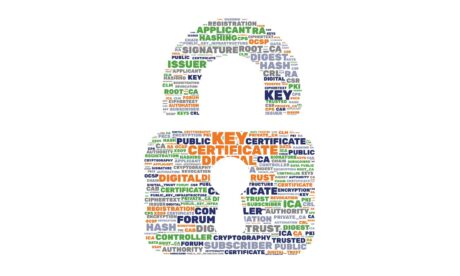15 PKI Uses and Applications (With Examples)
PKI is everywhere — it secures everything from websites and emails to the smart devices you use to secure your home and business. It’s the hero operating in the background…

PKI is everywhere — it secures everything from websites and emails to the smart devices you use to secure your home and business. It’s the hero operating in the background…

The CA/B Forum’s newly approved “Definitions and Glossary Chartered Working Group” aims to standardize industry language to create clarity and consensus of terms used in security guidelines Within the cybersecurity…

Verizon’s 2023 Data Breach Investigations Report (DBIR) data indicates that 86% of web app-related data breaches involved the use of stolen credentials. Explore 9 password cracking methods and how to…

Gartner reports taking “twice as many calls” about PKI and certificate lifecycle management (CLM) than multi-factor authentication (MFA)-related calls in 2023. Why is interest in PKI growing and why are…

Data from the FBI Internet Crime Complaint Center (IC3) indicates that reported business email compromise scam losses are up nearly 58% since 2020. See where your state stands regarding the…
PKI is everywhere — it secures everything from websites and emails to the smart devices you use to secure your home and business. It’s the hero operating in the background…
The CA/B Forum’s newly approved “Definitions and Glossary Chartered Working Group” aims to standardize industry language to create clarity and consensus of terms used in security guidelines Within the cybersecurity…
Verizon’s 2023 Data Breach Investigations Report (DBIR) data indicates that 86% of web app-related data breaches involved the use of stolen credentials. Explore 9 password cracking methods and how to…
Gartner reports taking “twice as many calls” about PKI and certificate lifecycle management (CLM) than multi-factor authentication (MFA)-related calls in 2023. Why is interest in PKI growing and why are…
Data from the FBI Internet Crime Complaint Center (IC3) indicates that reported business email compromise scam losses are up nearly 58% since 2020. See where your state stands regarding the…
Explore the public key infrastructure (PKI)-related lessons gleaned from public and private entities that got publicity for all the wrong reasons… PKI is a critical part of most IT…
Document signing isn’t just for PDFs. We’ll walk you through how to add a digital signature in Word using your document signing certificate on a Windows device Let’s cut to…
Although deepfake technologies are still in their infancy, falling for scams utilizing them can cost you millions. The good news is that there are steps you can take to make…
Knowing how to make your website secure can be the difference between sharing positive news with website users and having to inform them that their data has been breached. …
It seems like every time you turn around, new U.S. data privacy laws are popping up. The United States is an expansive country made up of 50 individual governing states,…
5 Ways to Determine if a Website is Fake, Fraudulent, or a Scam – 2018
in Hashing Out Cyber SecurityHow to Fix ‘ERR_SSL_PROTOCOL_ERROR’ on Google Chrome
in Everything EncryptionRe-Hashed: How to Fix SSL Connection Errors on Android Phones
in Everything EncryptionCloud Security: 5 Serious Emerging Cloud Computing Threats to Avoid
in ssl certificatesThis is what happens when your SSL certificate expires
in Everything EncryptionRe-Hashed: Troubleshoot Firefox’s “Performing TLS Handshake” Message
in Hashing Out Cyber SecurityReport it Right: AMCA got hacked – Not Quest and LabCorp
in Hashing Out Cyber SecurityRe-Hashed: How to clear HSTS settings in Chrome and Firefox
in Everything EncryptionRe-Hashed: The Difference Between SHA-1, SHA-2 and SHA-256 Hash Algorithms
in Everything EncryptionThe Difference Between Root Certificates and Intermediate Certificates
in Everything EncryptionThe difference between Encryption, Hashing and Salting
in Everything EncryptionRe-Hashed: How To Disable Firefox Insecure Password Warnings
in Hashing Out Cyber SecurityCipher Suites: Ciphers, Algorithms and Negotiating Security Settings
in Everything EncryptionThe Ultimate Hacker Movies List for December 2020
in Hashing Out Cyber Security Monthly DigestAnatomy of a Scam: Work from home for Amazon
in Hashing Out Cyber SecurityThe Top 9 Cyber Security Threats That Will Ruin Your Day
in Hashing Out Cyber SecurityHow strong is 256-bit Encryption?
in Everything EncryptionRe-Hashed: How to Trust Manually Installed Root Certificates in iOS 10.3
in Everything EncryptionHow to View SSL Certificate Details in Chrome 56
in Industry LowdownPayPal Phishing Certificates Far More Prevalent Than Previously Thought
in Industry Lowdown